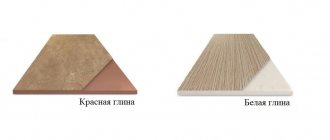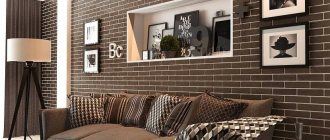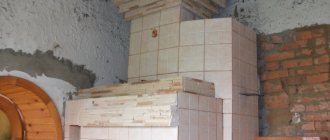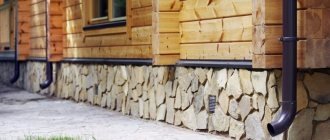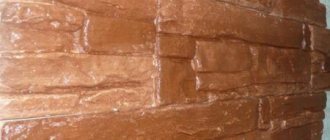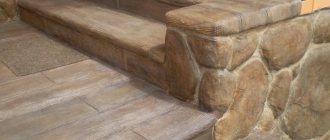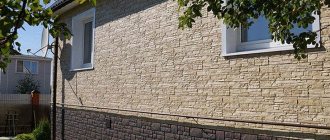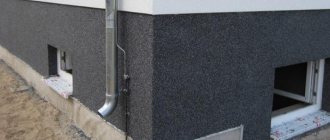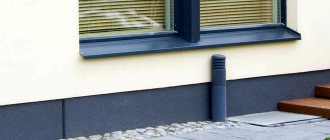Cladding is necessary for the plinth due to direct contact with the ground. Waterproofing this part of the building protects it and the walls of the house from moisture, dampness and rotting. But it alone may not be enough to constantly resist bad weather (rain, snow and the dampness that accompanies them). High-strength and moisture-resistant facing tiles used for the basement of a house can serve as good additional protection.
It is stronger and slightly thicker than facade tiles. In frame-type houses, in which the base protrudes beyond the boundaries of the walls, it is mandatory to make a drip to protect the base of the wall and the base from the accumulation of water. For a private homeowner who has construction skills, it will not be difficult to finish the base with tiles and make a base flashing (if necessary) on their own.
Under no circumstances should you use tiles (except polymer ones) for cladding the wooden base of a house.
Cladding is needed, at a minimum, to insulate the house
Requirements for tiles for cladding
Based on the expected loads on the base of the house, a number of requirements are imposed on the selected tile:
- Sufficient strength of the material. The structure of the tile must withstand significant mechanical and climatic loads.
- The resistance of the material to temperature changes is assessed, which is very important in regions with harsh climatic conditions.
- Greater thickness of the tile module than the thickness of the tiles for wall decoration.
- Advantageous design, which most models have (for example, clinker tiles for the plinth).
- Be sure to check the reliability of the manufacturing company, which has certified tile manufacturing technology.
Technical characteristics such as the degree of adhesion to the underlying base and the need to prepare the underlying surface for subsequent tiling are also important. The best tiles for the basement of a house fully meet all the requirements.
Why is the base covered?
Finishing the base with tiles (also called mutula) performs the following functions:
- Minimizing the negative impact of the environment and, first of all, increased humidity from precipitation, as well as the biological impact of the soil.
- Beauty and maintenance of the overall attractive appearance of the building
- Insulation of the house, since mutula not only has reduced thermal conductivity, but also increases the width of the protective layer.
- Emphasizing the boundaries of the building.
Advantages of basement cladding mutula:
- Easy to maintain and no need to carry out any further construction work after cladding.
- If the lining is installed correctly, its service life is comparable to the service life of the building.
- It withstands serious mechanical shocks without much damage, and in case of damage it is easily replaced, which is much cheaper than repairing the damaged part of the base of the house.
- The presence of many types, which allows you to choose the optimal one according to your tasks, price and quality.
In this video you will learn more about plinth cladding: Main types:
- from natural or artificial stone;
- clinker;
- polymers of various types;
- resin-based;
- ceramic;
- consisting of polyvinyl chloride panels.
Optimal selection criteria
The choice of tiles for cladding the basement, especially of a residential building, is best left to professionals. Construction specialists will prepare a project according to which all criteria will be taken into account:
- Soil characteristics and proximity to groundwater.
- The angle of inclination of the land plot. This parameter allows you to roughly estimate the risk of rainwater flowing under the foundation of a building.
- The height of the base and its length.
- Estimated mechanical load on the base of the house.
Specialists will draw up a diagram of the land plot, which will show the location of communication lines, in particular, sewer and water pipes.
Features of laying clinker tiles
After high-quality and thorough preparation of the base, you need to give the wall some time to dry. Then you will need to apply a primer to it. This is done to reduce the hydrophilicity of the wall structure, as well as to ensure maximum adhesion between the building material and the wall. After priming, you need to wait a little longer until the material is absorbed.
After the wall has dried, you need to start marking the work area. As mentioned above, it is better to start from the level of the first row of tiles and install a metal profile there.
Laying clinker tiles
To calculate the location of the first row, you need to measure the height of the base and divide it by the width of the tiles, not forgetting to add the width of the joints. Also using this method you can calculate the amount of material required.
The first row of clinker should be laid below ground level. During installation work, a small gap will inevitably arise. There is no need to worry about this; after installation is completed, it will need to be sealed with a sealing compound.
Return to content
Main types of tiles for cladding
Facade tiles, which are used for finishing the basement and not only (swimming pools, basements, underground garages), are produced using special technologies. The techniques used allow manufacturing companies to produce the following types of especially durable tiles on the construction goods market:
- Natural stone tiles.
- Porcelain tiles for the plinth.
- Clinker models with imitation of various surfaces (for example, stone tiles for the basement of a house).
- Material with a polymer structure.
- Tiles created on the basis of natural resins.
Today, ceramic facing tiles for plinths are also popular among craftsmen, however, this model is distinguished by a significantly larger module thickness.
Each of the known types of finishing tiles has a number of features, technical characteristics, and requirements for the underlying surface.
Types of plinth tiles for facades
Manufacturers offer various types of basement cladding materials that will help you update your home and choose an option that suits your design and budget. We invite you to learn about the most popular of these materials.
Clinker
Clinker tiles are a fairly popular building material for plinth cladding. They come in the form of tiles or brickwork. The popularity of this material is due to its strength and durability. Clinker tolerates any weather conditions well, does not absorb moisture and perfectly waterproofs the building.
There are several types of material:
- hand molding;
- produced by machine pressing.
These materials practically do not differ from each other, but, nevertheless, they are distinguished by density. During the pressing process by the machine, the clinker is given an increased density, thereby improving the characteristics of the cladding, such as resistance to frost, strength, and long service life. When deciding to cover the base with clinker, you should give preference to the material that is made by machine.
Porcelain tiles
Unlike clinker tiles, porcelain stoneware is rarely used for exterior cladding of a house. When selecting ceramics, you should pay attention to its operating conditions, since in order to finish the base of a building, it is necessary that the material be sufficiently frost-resistant. On the packaging of the material you can find a designation in the form of a snowflake.
Ceramic tiles have some drawback in the form of instability to impacts. Also, such tiles cost a lot, but they are presented on the market in a wide variety of colors, shapes and textures.
Polymer sand, hyperpressed tiles
Polymer sand tiles are similar to natural stone. According to operating conditions, it is the same as clinker, very durable. A positive property of such tiles is their fairly easy installation, since such tiles can be easily repaired and installed on the base of the house not only thanks to the glue, but also due to self-tapping screws.
Hyperpressed tiles are another type of finishing for the facade of a house. According to its characteristic features, it, like polymer sand, is similar to clinker tiles. Its difference lies only in the least weight and greatest strength. The main component in the manufacture of this tile is bulk materials, which are combined by water and binders.
Flexible tiles
Flexible stone is an artificial material produced on the basis of resin. The advantage of flexible tiles is that they can be laid on a base of complex configuration. This building cladding is available in the form of tiles and rolls. When heated, the rolls can be folded in any way. Also, flexible stone can be used not only for facade decoration, but also for interior wall decoration. It is simply dismantled and cut into the necessary pieces.
Natural and artificial stone
Natural stone is an expensive, but very durable material, which will also last quite a long time. The advantages of natural stone are its high decorative properties and long service life. Also, natural stone is difficult to damage, as it is environmentally friendly. The disadvantages of this finish are the high cost of the stone, its heavy weight and difficulty in installation. The size of the plinth tile can be arbitrary. When laying the facade, it is worthwhile to correctly select each stone to each other. Stone finishing may sometimes not be compatible with the cladding of the entire house, so it is worth choosing it based on the existing design of the entire house.
The composition of artificial stone includes sand, cement and many other additions that improve the aesthetics of the building and operating conditions. You can choose this material with any shade and shape. But such a stone has a main drawback - it does not absorb moisture well. If artificial stone is laid without following the appropriate technology, it may collapse after severe frosts. In order to prevent the bassoon from freezing, it should be soaked in warm water before installation.
Artificial
Natural
Siding
If you have a small budget, basement siding is perfect for finishing your home. This material is very popular when finishing exterior facades. Siding for the plinth also has the largest selection of additional materials. In addition to the ebb and corners, manufacturers produce such types of material as: starting, finishing strips and clamps for discreetly fastening tiles.
Large-format tiles for the plinth and facade are perfect for cottages. It is also called fiber cement panels, in the production of which nanotechnology is used with the introduction of special capsules into the tiles that work like a sponge. They are able to absorb moisture and return it back. In this way, optimal moisture can be maintained in the finishing material, which is why it can withstand any weather changes quite steadfastly.
Natural stone tiles
This type of material is the most expensive option, which requires significant financial investments in the tile itself, in preparing the base, and installing a decorative coating.
Popular models include tiles made of marble, granite, slate, and limestone. Such compositions have sufficient strength, perfectly protect the base from moisture, and easily tolerate temperature changes.
Note!
Epoxy grout for tiles: pros and cons, scope, varieties, how to work with it (instructions + photos)
Do-it-yourself tile shower tray step by step: instructions, dimensions, design, installation of communications, types of structures, photos
White tiles in the bathroom: 170 photos of the best ideas and new tile designs. Layout schemes and beautiful combinations
Features of installation of various types of tiles
To cover the base with special tiles, various methods are used, which depend on the choice of tile material. Installation work should always begin with surface preparation. It is necessary to clean the surface of dirt and remove all irregularities. Wooden walls are leveled with bars of different thicknesses, and block or brick walls are leveled by plastering.
Laying tiles directly depends on its type:
- To lay artificial or natural stone, a special adhesive solution or cement glue is used. Glue is applied to each tile, after which it must be pressed tightly against the wall. The seams are filled with mortar. In some cases, additional installation of reinforcing mesh may be required.
- Clinker tiles are installed starting from the top row. When laying, glue is applied to both the tile and the wall, after which the joints are grouted.
- The polymer tiles are mounted with glue, after which they must be protected from moisture for three days. And only after this can the seams be rubbed.
Using different types of tiles for the basement will protect the house from moisture and pollution. When choosing the optimal type of tile, you should take into account the climate of a particular region, the weight and material of the structure, as well as the external characteristics of the material.
Artificial stone tiles
This coating often acts as an alternative option for cladding the base. Its strength is in no way inferior to the previous type of coating, especially if the production technology uses a combination of natural stone and artificial stone chips.
Thanks to modern technologies, tiles with a smooth or textured surface are being released onto the building materials market, which will allow you to experiment with the design of the base. The admixture of coloring pigments and natural chips gives the surface of the tile modules a unique design and pattern.
Stages of preparation of the base
Whatever options or materials you choose for finishing the base, you need to start with preparation. As a good rule, it is advisable to first arrange drainage; without removing moisture from the building, both natural and artificial finishing of the base can quickly become unusable; this process is shown in detail with photos, videos and diagrams “HERE” .
Basement waterproofing
In this case, roll, coating and penetrating waterproofing can be used.
- A budget option for roll waterproofing is considered to be roofing material mounted on bitumen mastic. But it’s better to take weld-on rolls, for example, membranes from TechnoNIKOL. The monolith is primed, after which the membrane is heated with a burner and gradually rolled out over the foundation.
Rolled foundation waterproofing is reliable, but difficult to install
- There are a lot of coating compounds now; they are convenient because they are applied with a regular spatula. I recommend taking “Liquid Membrane 3 in 1” waterproofing or “Liquid Glassine” makes them. These are one-component compositions that do not require a primer or any preparation at all.
“Liquid Membrane 3 in 1” is a universal waterproofing material, while “Liquid Glassine” is more focused on wooden bases
- Penetrating waterproofing is also very convenient; the composition is applied to concrete or brick and clogs the internal pores of the material to a depth of 30 cm. At domestic construction sites, Penetron is considered the most popular brand.
Before exterior finishing of the base, the monolith is treated with penetrating waterproofing "Penetron"
Blind area
A blind area is a path around the perimeter of a house; it is needed to drain rain and melt water from the wall. To lay paving slabs at an angle, you need experience, but you can make a concrete blind area with your own hands.
- The blind area is made 300 mm wider than the roof extension.
- The soil is removed to a depth of 300 - 400 mm.
- The bottom of the trench is compacted and covered with rolled waterproofing.
- At 200 mm, the trench is filled up and compacted with a sand-gravel mixture.
For waterproofing, you can use regular roofing felt.
- It is better to insulate the blind area, so EPS sheets are laid next. To save money, you can take foam with a density of 30 units and higher.
- Another layer of waterproofing is covered.
- Wooden formwork is being installed.
- A reinforcement frame is laid inside.
- Concrete is poured into the formwork and leveled at an angle of 30 - 40 mm from the house.
The blind area is deliberately divided into sectors with wooden formwork in order to avoid cracks from seasonal soil deformations
Clinker tile types
The most well-known material for finishing the basement of a building today is clinker tiles. It has a very durable structure and resistance to a number of damaging factors.
On the finishing materials market you can find stone-like clinker tiles for decorating the base. The material can be used without replacement for decades, and its resistance to moisture, hail, and chemical compounds is the highest among all known coatings.
Kinds
Base tiles are a collective name for several types of cladding made from different materials, such as :
- Clinker room. One of the most durable materials, resistant to all manifestations. Available in imitation stones of various types or bricks. In the latter case, there is not so much imitation as a change in thickness - clinker tiles and bricks are made from the same material using the same technology, so in this case there is a variety, not an imitation.
- Polymer-sand . This cladding has high elasticity, frost resistance and moisture resistance. The appearance of the material predominantly imitates roughly processed stone, less often brickwork. The low weight of the cladding facilitates use on weak load-bearing structures. Installation with glue or self-tapping screws is possible - the so-called. dry method.
- A natural stone. The most expensive option, both material and installation will cost a substantial amount. Different types of stone are used - slate, marble, limestone, granite, etc. The sizes of the slabs also have many options, depending on the configuration and external features of the material . Installation requires an experienced specialist, since the installation of natural stone requires taking into account some specific features and expansion coefficients of different types of stone.
- Artificial stone, or porcelain stoneware. A composite material, most often representing a melt of various components of natural and artificial origin. It has many appearance options , smooth or rough surface, the presence or absence of a specific relief or texture. The performance characteristics are practically no different from those characteristic of natural stone. The cost of the material is high, but recently there has been some reduction in prices due to developments in technology.
- PVC panels . An alternative option that creates a lightweight and airtight plinth sheathing. The best way to protect lightweight buildings that cannot withstand the load from more massive types of cladding. Resistant to moisture, temperature changes, and UV rays. They have a fairly high coefficient of thermal expansion, which should be taken into account when installing . When vinyl freezes, it becomes brittle, limiting its use in the basement levels of homes with heavy traffic of people or equipment in close proximity to walls.
Polymer based tiles
Polymer facade tiles for exterior finishing of basements are very popular. The production technology uses the optimal ratio of sand, synthetic polymers, coloring pigments and stabilizers.
Note!
Italian tiles for floors and walls: photos of beautiful tile designs in the bathroom and kitchen. Choosing tile color, style and size
Marble tiles for the bathroom: TOP-200 photos of original design, ideas for mixing and matching
Do-it-yourself tile shower step by step: instructions, algorithm of actions, dimensions, layout diagrams, photo of a shower with and without a tray
It is the presence of the last ingredient that gives the surface of the tiled module special strength and resistance to moisture and other climatic factors.
A distinctive feature of this coating is the possibility of attaching blocks to waterproofing using ordinary screws or self-tapping screws. Facing the facade with polymer tiles allows you to hide all existing irregularities on the surface of the base.
Choosing the type of tile for the plinth
The plinth can be tiled using a variety of materials. When choosing them, you should take into account the material from which the house is built, as well as the external and operational characteristics of the facing material. Almost any type of finishing of the basement of a house is suitable for buildings made of aerated block or brick, and the cladding of a wooden house is most often done with plastic tiles. Finishing the base with tiles can be done on the basis of various materials, each of which has a number of advantages and disadvantages.
Natural stone
Cladding the base with stone allows you to create a solid, massive and beautiful appearance of the house. The cost of natural stone is quite high, but its use allows you not to think about repairing and replacing tiles for many years.
Stone-based finishing tiles are finished only in the part where it comes into contact with the wall. The front part undergoes minimal processing to preserve the natural texture.
Natural stone tiles should be laid on cement adhesive, and then the seams between them should be sealed with a special grout. Despite their excellent performance properties, even tiles made from rough cobblestones need to be treated every few years to improve their moisture-resistant properties.
Fake diamond
Covering the base with concrete tiles with imitation stone is extremely popular. Stone-effect tiles are made on the basis of cement and sand with the addition of plasticizers to increase the strength and durability of the product. Stone-effect tiles have good water resistance, so they can be washed. Basement tiles, torn stone, shell rock or rock, are an excellent solution for decorating a home in any style. Artificial stone, like natural stone, requires periodic treatment with special compounds to improve its moisture-resistant characteristics.
Concrete tiles with imitation stone are placed on a special adhesive solution for stone. To create the feeling of a complete composition, the seams between the tiles are filled with elastic jointing mortar.
Clinker tiles
Clinker tiles for the plinth look like bricks. For its production, purified clay is used, to which coloring components are added, as well as ingredients to improve the characteristics of the finished brick tiles. To produce clinker tiles, the masses are laid out in special molds, after which the air is removed and the solution is compacted. Clinker tiles are fired at temperatures above 1000 degrees, which allows all components to firmly melt together.
When the tiles cool, they acquire a pre-selected color and a smooth, glossy surface. To cover the corners, special corner elements are produced. Covering the base with clinker tiles allows you to protect the facade and foundation from moisture, mechanical damage and contamination.
Clinker plinth tiles for facades are installed on an elastic and frost-resistant adhesive solution, which is applied to the tiles and the base. Only in this case can a strong adhesion be ensured. It is recommended to apply the solution only to a small area, which can be covered in 15-20 minutes. After a few days, the seams between the tiles should be sealed using clinker jointing mortar. You can lay tiles on almost any base. Basement clinker tiles do not absorb moisture, so they do not need to be treated with moisture-resistant impregnation.
Polymer tiles
Polymer tiles are made from fine sand and special additives. Polymer sand tiles are used to decorate the external walls of a private house. The base lined with such material visually resembles brick or torn stone.
Polymer facade tiles are lightweight, which makes it possible to use them for finishing even light structures with low load-bearing capacity. When facing foundations and facades, this material does not chip or crack due to its high degree of plasticity. In addition, such plinth tiles have good moisture resistance, so they do not require additional processing.
To cover the facade and foundation with such material, you should attach the tiles using screws to the sheathing. Additionally, you can place a layer of insulation behind the cladding.
Resin based tiles
Resin-based plinth tiles can imitate sandstone or clinker brick. It has a small thickness and weight. In addition, such facade plinth tiles are also flexible, which allows them to be used for finishing arched surfaces and corners.
When working, tiles can even be cut with scissors, and working with them does not require special tools or skills. Decorative tiles can be installed on a layer of thermal insulation, concrete or plaster. To cover the surface, a special glue is used, which is applied using a notched trowel. Laying tiles does not include joint processing. The protruding glue acts as a fugu.
Ceramic tile
Porcelain tiles for the plinth are made on the basis of clay, iron, quartz sand and other environmentally friendly materials, so ceramic tiles are absolutely safe for humans. Modern technology makes it possible to make ceramic tiles a solid material without pores or voids. This increases its moisture resistance, fire safety, and heat-protective qualities. Finishing the base with ceramics imitates natural stone, giving the house a noble and massive appearance.
Installation of plinth tiles includes installation of the frame, installation of a waterproofing layer and fastening of porcelain stoneware to the plinth. The frame is attached using self-tapping screws, and the tiles are attached to the frame using a thick layer of concrete.
Tiles based on natural resins
A very interesting version of facing tiles can be found in modern construction supply stores. The use of various resins in production allows you to create a unique material that bends at any angle.
If necessary, modular blocks can be cut with construction scissors. After laying, the tiles will provide reliable protection against natural moisture, but only if the finishing work is carried out optimally.
For the glue to completely and successfully harden, it will take about three days and absolutely dry weather.
Note!
Mosaic from broken tiles: step-by-step instructions on how to lay it out with your own hands (140 photo ideas)
Mosaic for the bathroom: TOP-150 photos of new designs, as well as modern ideas for combining mosaic tiles
Do-it-yourself water heated floor under tiles step by step: installation instructions with photos and descriptions, installation and connection
Preliminary surface finishing
One of the key points of construction and finishing work is the preparation of the underlying surface. Laying the plinth with tiles begins immediately after the preparatory work:
- The old coating from the base must be removed. Pay attention to even the smallest pieces that can cause poor adhesion of the new material.
- The surface of the base must be leveled, especially if there are unevenness and gross defects.
- After thorough cleaning of dust, they begin laying hydro- and thermal insulation. If necessary, install a reinforcing mesh.
Applying several layers of primer to the surface will increase the resistance of the facing tiles to low temperatures.
Base cladding options
The base is the part of the foundation from the ground zero point to the floor line of the first floor of the building or the beginning of the wall. In this case, we are interested in houses in which there is a continuous monolith from the ground to the walls.
Important! In houses on columnar and pile foundations, the gap between the soil and the building is first covered with a strong shield and only then is this shield lined with stone, tiles, etc.
| Base finishing options | ||||||
| Polished stone It is possible to clad a house with marble or polished granite, but the price of these materials is exorbitant, plus an amateur cannot do such work on his own. | Sandstone Finishing the base with flagstone, sandstone or plaster is considered the golden mean when facing a private house. (In essence, these are 3 names for the same cladding) For an amateur on a limited budget, this is a great way to decorate a base with natural stone, plus the cladding technology is simple, but more on that later. | Fake diamond In essence, these are the same tiles, only decorated to look like natural stone. There are 2 directions of artificial stone: 1. Polymer-acrylic stone is a lightweight and affordable material, but in this niche there are many fakes that fade in the sun. 2. Pressed stone - here 80% of dust or crumbs of natural mineral and 20% of a polymer binder are taken, after pressing, a material similar to natural is obtained. | Brick To finish the base with brick, it is advisable to take a solid facing brick with good firing. The material is of high quality, but heavy; support for it is laid at the stage of constructing the foundation.
| Tiles Tiles are perfect for finishing the basement. Typically, the above-mentioned clinker tiles are used for these purposes. The finishing of the base with porcelain stoneware, especially marbled, looks good. A practical solution would be the option with thermal panels, as in the photo on the left, where clinker is already glued onto the extruded polystyrene foam (EPS), you only need to fix the panels to the foundation and immediately get finishing and insulation of the base. | Decorative plaster Cladding with decorative plaster looks interesting, but such compositions are expensive, and most importantly, not every amateur can plaster a wall evenly. | Siding Finishing the base with siding panels is now very popular. There are plastic, cement and metal panels. Installation is carried out using the “ventilated facade” technology and you immediately receive insulation and cladding.
|
Do-it-yourself tiling of the base with tiles
In practice, two main methods of tiling the base are used: dry and wet (classic finishing) methods. Step-by-step finishing of the basement of a house with tiles using the dry method:
- Attach a lathing made from a profile to the prepared surface.
- They begin to attach the facing tiles on top of the sheathing using self-tapping screws.
The technique is quite simple, but has its drawbacks. It is impossible to achieve complete tightness in this way, which means that moisture will get between adjacent tile modules.
The second method of finishing the plinth with facade tiles is recognized as classic, and is more often used in practice:
- After installing the reinforcing mesh (this stage of work is optional), an adhesive solution is applied to the surface of the base. Reinforcing mesh is often used when finishing the base with clinker tiles.
- Tile laying begins from the upper far corner, constantly monitoring the quality of the arrangement of tile modules using a building level.
- Be sure to maintain the time required for the adhesive to dry.
After the solution has completely hardened, they begin to grout the joints with a moisture-resistant compound. For ease of use, spatulas of various sizes are used. This approach makes it possible to make the tile masonry completely sealed and resistant to moisture.
The nuances of laying tiles for the plinth
The main problem with tiling the basement of a building is the large size of the horizontal row. Even for experienced specialists it is quite difficult to lay the plinth row evenly. It is because of this that it is worth paying attention to the initial row. It is laid along the established line. It is worth attaching a long level rail to the base, which is used as a base for the first row. When tiling the top part, the lath should be removed and the remaining tiles laid.
It is also worth paying attention to such nuances as:
- selection of glue that ensures installation and durability of the finish. Regular tile adhesive will not work in this case - you need the most durable adhesive that is resistant to moisture and frost. It is also possible to use waterproofing mixtures when laying slabs;
- reinforcing mesh is also necessary for the integrity of the cladding material. Even if one tile is poorly attached, this mesh will hold it. In addition, it provides excellent adhesion of tiles to the building;
- low tide - helps prevent rain and water from entering the base. The tile will not crack during frosts and will be resistant to humidity. Basically, ebb is used when installing materials such as artificial stone.
Types of adhesive for laying tiles on a plinth
Metal reinforcing mesh
Steel casting with polymer opening
If you follow all the nuances of laying the tiles for the plinth, they will retain their aesthetic appearance for a long time and decorate the facade of the house.
Using a plinth, you can decorate a house using various methods based on your budget, the building materials, the architectural style of the building, and the wishes of the owner of the house. It is recommended to focus on the weight of the tiles, their thickness or cost.

